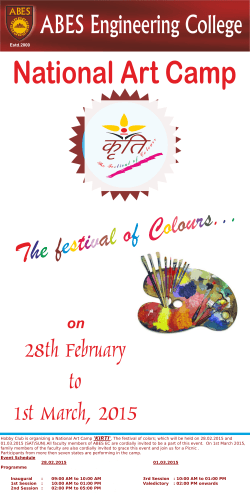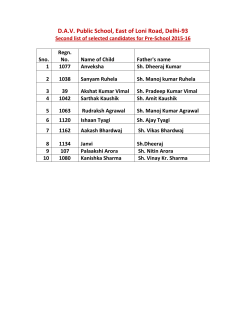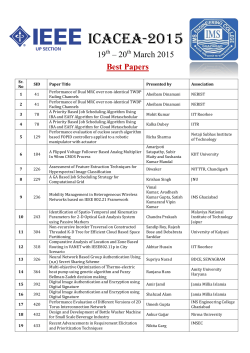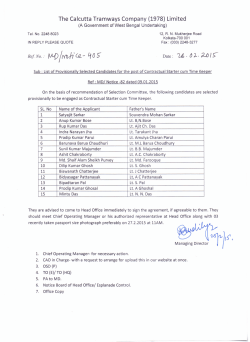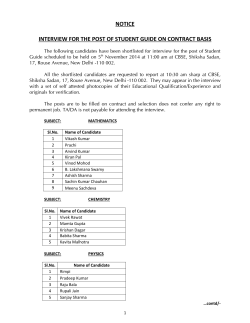
IRJAES-V1N2P10Y16
International Research Journal of Advanced Engineering and Science ISSN: 2455-9024 Effect of Chandanadi Lepa in the Management of Parikartika W.S.R to Acute Fissure in Ano Tapish Maheshwari1 , Shaleni Yadav2 , Rajnish kumar Gautam3, Ajai Kumar4, Vivek Bhatt5, Pankaj Kumar Sharma6 , Vishal Verma7 1, 4, 5, 6, 7 PG Department of Shalya Tantra, Rishikul Campus, Uttrakhand Ayurved University, Haridwar, India 2 PG Department of Rachna Sharir R.A.C Lucknow, Lucknow University, India 3 PG Department of Kay- Chikitsa Email address: [email protected] “Parikartika” was one condition found to be similar to fissurein-ano onbasis of symptoms, so we can considered Parikartika as Fissure in ano in this research work. Acharya Sushruta has described the term “Parikartika [5]” as a condition of Guda in which there is cutting and burning pain. Similarly Dalhana, Jejjata have also clearly described Parikartika as a condition which causes cutting pain in anus. Acharya Charaka and Vagabhatta used two words, “Vikartika” as well as “Parikartika” for denoting the condition. Chakrapani also opines the same. The factors responsible for causation of parikartika are found in various texts asVamana-Virechanavyapada [6], Bastikarmavyapada, Atisara [7], Grahani, Arsha [8], Udavarta [9] etc. Very lately in chronology Acharya Kashyapa [10] has described it in three type viz. Vataja, Pittaja and Kaphaja. Acharya Sushruta while describing the symptoms of the disease he speaks of the features like cutting or burning pain in anus, penis, umbilicus and neck of bladder with cessation of flatus, whereas Charaka has described the features like, pricking pain in groins and sacral region,scanty constipated stools and frothy bleeding per anus. According to Acharya Charaka the people living in Jangala pradesha aredry and they have dry food that vitiates vata and produces vibandha or constipation. There is already prevalence of fissure-in-anoin higher rate, and urbanization has added to it. So an alarming rise in the incidence of the disease fissure-in-ano and no known satisfactory remedies evolved so far, has given an impetus to find out a suitable solution, with although better effects, from amongst the treatments advocated by the ancient Acharyas. It is also the demand of time that least duration of treatment and easy accessibility are major consideration. Material & methods - The study was conducted on randomly single groups (30 patients) on the basis of criteria of inclusion and exclusion with detailed clinical history and physical examination and other necessary/desired investigations. Abstract—Fissure in ano has been and still is being the most common anal pathology. Also in recent times, it has come up to be a pandemic disease. Thus like common cold (coryza) it has become a very common entity, that affects a large percentage of civilization at least once, or more at some stage of their life span. In Ayurveda, Parikartika disease closely resembles with Fissure in ano of modern medicine in its signs and symptoms. A clinical trial was conducted on a group of 30 patients diagnosed with Acute Fissure in ano. Patients were selected randomly irrespective of their religion, race, occupation, sex etc. They were administered Chandanadi lepa, a herbal formulation, at a dose of 250 mg Bid a day for three months for local application on ulcer and monitored at every 15 days interval during the study period. Symptoms of Fissure in ano like Pain, Bleeding, and Burning sensation were observed over the treatment. Analysis of result showed improvement in Parikartika (Acute Fissure in Ano). Finally study concluded that Chandanadi lepa is effective for Parikartika. Keywords— Acute Fissure in ano, Chandanadi lepa, Parikartika. I. INTRODUCTION Fissure-in-ano [1] is a disease which recurs or is apt to additional trouble after conventional surgery. Many techniques have been tried, each by no means better than the other. It is a small longitudinal ulcer in long axis of lower anal canal producing too much of pain when compared to its size. The common causes are constipation, spasm of internal sphincter, or secondary due to systemic conditions like ulcerative colitis etc. and also when too much of skin is removed in haemorrhoidectomy [2] or surgeries of fistula-in-ano. It occurs most commonly in the midline posteriorly, the least protected part of the anal canal. It is more common in youngsters and in reproductive age of females [3]. This condition makes it even more necessary to find out an easily accessible and result oriented remedy to improve the condition of young individuals for better outcome on their part. Pregnancy is a boon to a woman, but fissure-in-ano is a condition occurring during pregnancy and antepartum due to injury by foetal head, making pregnancy a dreadful experience. Also during pregnancy no surgical intervention and very less purgatives are prescribed. This again leaves a pit hole in the management techniques of fissure-in-ano, demanding for an applicable therapy even during pregnancy. In male, fissures usually occur in the midline posterioly – 90% and much less commonly anteriorly – 10%. In female, fissures on the midline posteriorly – 60% are slightly commoner than anteriorly – 40% [4]. II. AIMS AND OBJECTIVES The aim and objective of the study was– To evaluate the clinical resemblance/correlation of Parikartika with Fissure in ano. To evaluate the effect of Chandanadi lepa in the management of Parikartika w.s.r. to Fissure in ano. 13 Tapish Maheshwari, Shaleni Yadav, Rajnish kumar Gautam, Ajai Kumar, Vivek bhatt, Pankaj Kumar Sharma, and Vishal verma, “Effect of chandanadi lepa in the management of parikartika W.S.R to acute fissure in ano,” International Research Journal of Advanced Engineering and Science, Volume 1, Issue 2, pp. 13-16, 2016. International Research Journal of Advanced Engineering and Science ISSN: 2455-9024 To provide a reliable, cost effective ayurvedic treatment for Parikartika with minimum recurrence. Plan of Study 1. Criteria of selection of patient 2. Ctiteria for diagnosis 3. Criteria for assessment 3 Patient complains of executing pain during and after defecation for few hours, but pain is relieved only with some medicine and not hamper normal routine. 4 Patient struggles due to pain all the day long and his normal routine is hampered and he had drastic medicine for same. 3. Raktasrava (bleeding): 1. Criteria of Selection Inclusion criteria 1. All cases of acute fissurein ano in anyage group. Criteria for exclusion HIV & HbsAg patients Diabetic patient Chronic fissure Chronic fissure with tag Fissure d/t any other systemic disorderUlcerative colitis Crohns disease Tuberculosis Carcinoma of Rectum & Anal canal 0 No bleeding 1 Bleeding along with defecation streak wise only over the stool /noticed on fissure rarely 2 Drop wise bleeding during and after defecation 0-10 drops occasionally. 3 Drop wise bleeding during and after defecation 10-20 drops stopped. 4 Profuse bleeding drop wise or stream wise amounting more than 20 drops in each defecation Subjective Parameter 1. Mehana Daha (Burning Micturation) 2. Mehana Pida (Pain) 3. Sirahsula (headache) 4. Nabhisula 5. Aniyat Vibandha 6. Agnivaisamya 7. Avipaka 8. Atopa Diagnostic Criteria Diagnosis was made on the basis of typical sign & symptoms of acute fissure in ano. Period of Study: 3 month Follow up: After 15 days for 1 month. III. OVERALL EFFECT OF THERAPY Overall effect of the therapy was assessed in terms of Cured, Marked Improvement, Moderate Improvement, Mild Improvement and Unchanged by adopting the following criteria. Objective Parameters 1. Gudadaha (burning sensation): 0 No Gudadaha 1 Patients complains of Daha only during interrogation 2 Patients complains of Daha during and after defaecation which is relieved after some time without medicine. Cured : 100% relief in chief complaints and no recurrence during follow up study was considered as cured. 3 Patient complains of daha during and after defeacation for some hours and relieved only with some medicine. Marked Improvement : > 75% improvement in chief complaints was recorded as marked improvement. 4 Patient complains of daha that is sour all through the day hampering his normal routine work. Moderate Improvement : 51 to 75% improvement in chief complaints was considered as moderate improvement. Mild Improvement : 26 to 50 % improvement in chief complaints was considered as mild improvement. Unchanged : Up to 25% reduction in chief complaints was noted as unchanged. 2. Guda Pida (cutting pain): 0 No pain 1 Patients complain only when interrogated and pain is relieved after defecation immediately on its own. 2 Patients complain of pain during after defaecation for few hours but pain is relieved without medicine and not hamper normal routine. IV. OBSERVATIONS AND RESULTS Effect on pain No. of days 15 days 30 days 45 days 60 days 75 days 90 days Mean BT AT 2.4 1.56 2.4 0.46 2.4 0.06 2.4 0.06 2.4 0.06 2.4 0.06 Mean diff % relief SD SE t-value p – value Significance 0.83 1.93 2.33 2.33 2.33 2.33 34.72 80.55 97.22 97.22 97.22 97.22 0.67 0.63 0.71 0.71 0.71 0.71 0.06 0.11 0.12 0.12 0.12 0.12 12.04 16.55 17.97 17.97 17.97 17.97 <0.001 <0.001 <0.001 <0.001 <0.001 <0.001 H.S H.S H.S H.S H.S H.S 14 Tapish Maheshwari, Shaleni Yadav, Rajnish kumar Gautam, Ajai Kumar, Vivek bhatt, Pankaj Kumar Sharma, and Vishal verma, “Effect of chandanadi lepa in the management of parikartika W.S.R to acute fissure in ano,” International Research Journal of Advanced Engineering and Science, Volume 1, Issue 2, pp. 13-16, 2016. International Research Journal of Advanced Engineering and Science ISSN: 2455-9024 Effect on burning sensation No. of days 15 days 30 days 45 days 60 days 75 days 90 days Mean BT AT 2.30 1.20 2.3 0.43 2.3 0.2 2.3 0.13 2.3 0.10 2.3 0.06 Mean diff % relief SD SE t-value p – value Significance 1.1 1.8 2.10 2.16 2.20 2.23 47.82 81.15 91.30 94.20 95.65 97.10 0.30 0.68 O.66 0.59 0.61 0.56 0.05 0.12 0.12 0.10 0.11 0.10 11.74 15.00 17.38 20.04 19.74 21.52 <0.001 <0.001 <0.001 <0.001 <0.001 <0.001 HS. H.S H.S H.S H.S H.S Effect on bleeding No. of days 15 days 30 days 45 days 60 days W75 days 90 days Mean BT AT 1.23 0.20 1.23 0.03 1.23 0.03 1.23 0.03 1.23 0.03 1.23 0.03 Mean diff % relief SD SE t-value p – value Significance 1.03 1.2 1.2 1.2 1.2 1.2 83.78 97.29 97.29 97.29 97.29 97.29 0.76 0.84 0.84 0.84 0.84 0.84 0.13 0.15 0.15 0.15 0.15 0.15 7.39 7.70 7.70 7.70 7.70 7.70 <0.001 <0.001 <0.001 <0.001 <0.001 <0.001 HS H.S H.S H.S H.S H.S Total effect of therapy local symptoms Symptoms Tenderness Sphincter spasm Mean B.t A.t 1.13 0.30 1.16 0.3 X % relief SD SE t – value p – value Significance 0.83 0.86 93.52 74.28 0.37 0.50 0.06 0.09 12.04 09.35 <0.001 <0.001 HS HS Total effect of therapy on general symptoms Symptoms Mehan Daha Siraoshoola Nabhishoola Aniyat vibandha Agni vaisamya Avipaka Atopa Mean B.t A.t 0.066 0.033 0.533 0.133 0.4 0.233 1.2 0.3 1.13 0.33 0.83 0.3 0.66 0.3 X % relief SD SE t – value p – value Significance 0.033 0.4 0.166 0.9 0.47 0.53 0.366 50 75 41.00 75.00 70 64 55 0.18 0.72 0.37 0.66 0.71 0.62 0.7 0.033 0.13 0.069 0.20 0.13 0.11 0.13 1 3.02 2.40 7.44 6.13 4.64 2.79 <0.10 <0.001 <0.01 <0.001 <0.001 <0.05 <0.01 N.S HS S H.S H.S S S Overall effect of therapy Effect of therapy Result on effect of therapy No. of Pt. % Complete cured 25 83.33 Marked Improvement 0 0 Moderate Improvement Mild Improvement Unchanged 0 5 0 V. SUMMARY This paper entitled “Effect of Chandanadi Lepa in the Management of Parikartika W.S.R To Acute Fissure in Ano” was planned under five broad headings as described below: Total 30 patients were randomly selected, and diagnosed for acute fissure in ano. In all patients Chandanadi lepa applied twice daily on ulcer. All patients were given routine oral medication- Panchatiktaghrita guggulu and hot sitz bath. So, here on the basis of this study the following observations can be drawn – Maximum patients were belonging to age group 26- 35 years (36.66%) Maximum patients 90% were male. Maximum 60 % patients were related to the rural area Most of the patients belonging to the Hindu religion (86.66%) Most of the patients were belongs to lower middle class 24 (80%) Highest number of the patients i.e. 60% were leading sedentary life style. Highest number of the patients i.e. 60% were married. Most of the patients of Fissure in ano were literate (73.33%) Maximum patients were addicted to tea (80%), 33.33% to smoking, 16.66% to tobacco chewing, 13.33% to alcohol and 6.66% to coffee. 0 16.66 0 Recurrence No. of Patient % of Patients 05 16.66 Probable Mode of Action of Chandanadi lepa [11] The important factors which keep a fissure-in-ano away from normal healing, are constant contamination of the wound by faeces and frequent friction with the mucosa while there is continuous spasm of the sphincteric muscles. In such situation, a drug which produces a soothing effect, dahashamak, Vrana Ropana, Vedana har and Vata-pittahara action, is more suitable. Here Chandanadi lepa has been selected for the present study due to having the same properties and good soothing effect. Vata-pittahara property may be due to its Ghrita base and it probably removes the accumulated secretions in the fissure bed, promotes healing and reduces secondary infection too. It may be due to its Vrana Sodhana, Vrana Ropana, sothahara and Vedanasthapana properties. 15 Tapish Maheshwari, Shaleni Yadav, Rajnish kumar Gautam, Ajai Kumar, Vivek bhatt, Pankaj Kumar Sharma, and Vishal verma, “Effect of chandanadi lepa in the management of parikartika W.S.R to acute fissure in ano,” International Research Journal of Advanced Engineering and Science, Volume 1, Issue 2, pp. 13-16, 2016. International Research Journal of Advanced Engineering and Science ISSN: 2455-9024 Maximum number of patient i.e 77% having mixed diet pattern. 40% were having Vata-pitta prakriti. 70% were noted of Madhyama Sara Maximum numbers of patients i.e. 66.66% patient were noted of Madhyama Samhanan. Maximum numbers of patients i.e. 70% were noted of Madhyama Satva. Maximum numbers of patients i.e. 40% were noted of Madhyama praman. Out of 30 patients most of the patients 100% were belonging to Sadharana Desha. Maximum numbers of patients i.e. 66.66 % were noted of Madhyama Ahar Shakti. Maximum numbers of patients i.e. 40% were noted of abhyavaran Shakti. Maximum numbers of patients i.e. 43.33% were noted of Madhyama jaran Shakti. Maximum i.e. 13.33% patients were having positive family history. Maximum number of patientsi.e.90.00% reddish 10.00% whitish. Maximum number 86.66% patients had fresh blood discharge on examination. Most of the patients i.e. 97% were having Acute fissure. Most of the patients i.e. 78.12% were having fissure at 6’0 clock. Most of the patients 100% come with a complaint of pain, 96.66% Burning sensation, 73.33% patients complaint Bleeding. Most of the patients 93% come with a complaint of sphincter spasm, and 90% patients were complaint of tenderness. Maximum number of patients i.e. 90.00% had Aniyat Vibandha, followed by 83.33% patients had agni vaisamya, 70.00% patients were having Avipaka, followed by 40.00% patients were having Atopa, 33.33% patients having Sirasula 26.66% patients had nabhishula, followed by 06.66% patients were having Mehan daha. In Chandanadi lepa (local application), it was found that each 83.33% patients were cured, 16.66% patients moderately improved. So, from the above mentioned facts, thoughts, data and results it can be summarized that Chandanadi lepa can be good alternative for relieving cardinal symptoms, general symptoms and quick healing of ulcer in the patients of Parikartika (fissure-in-ano) and even economical also to the patients. REFERENCES Baily an d Love`s, Short Practise of Surgery, 23rd edition, International Students` Edition Edited by R.C.G. Russell, chapter 61, pp. 1125. [2] Baily and Love`s, Short Practise of Surgery, 23rd edition, International Students` Edition Edited by R.C.G. Russell, chapter 61, pp. 1126. [3] S. Das, A Concise Textbook of Surgey, 5th edition, chapter 54, pp. 1084p [4] S. Das, A Concise Textbook of Surgey, 5th edition, Chapter 54, pp. 1085, 2012. [5] Shushruta Samhita edited with Ayurveda-Tattva-Sandipika by Kaviraja Ambika Dutta Shashtri Chaukhambha Publications Reprint 2009 Chikitsa sthana, Chapter 34 /3, pp. 183. [6] Charak Samhita, Vidyotani hindi vyakhyopeta by Pandit Kashinath Pandey and Gorkshnath Chaturvedi , Chaukhamba Publication Reprint 2010- Siddhisthana, Chapter 6/30, pp. 1023. [7] Charak Samhita, Vidyotani hindi vyakhyopeta by Pandit Kashinath Pandey and Gorkshnath Chaturvedi , Chaukhamba Publication Reprint 2010- Chikitsasthana, Chapter 19/5, Page 558. [8] Charak Samhita, Vidyotani hindi vyakhyopeta by Pandit Kashinath Pandey and Gorkshnath Chaturvedi , Chaukhamba Publication Reprint 2010- Chikitsasthana, Chapter 14/17 Page 422. [9] Charak Samhita, Vidyotani hindi vyakhyopeta by Pandit Kashinath Pandey and Gorkshnath Chaturvedi , Chaukhamba Publication Reprint 2010- Chikitsasthana, Chapter 26/6 Page 717. [10] Kashyapa Samhita, Vidyotani hindi vyakhyopeta Kashi sanskrita granthmala Khil sthana Antarvartini chikitsa 10/ 102-104. [11] Bhaishjya Ratnavali – Shri Govinda Das, Motilal Banarasidas Publishers New Delhi, Reprint 2005, 71/82. [1] Before treatment After treatment 16 Tapish Maheshwari, Shaleni Yadav, Rajnish kumar Gautam, Ajai Kumar, Vivek bhatt, Pankaj Kumar Sharma, and Vishal verma, “Effect of chandanadi lepa in the management of parikartika W.S.R to acute fissure in ano,” International Research Journal of Advanced Engineering and Science, Volume 1, Issue 2, pp. 13-16, 2016.
© Copyright 2025




